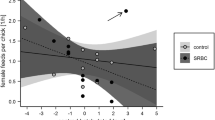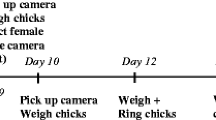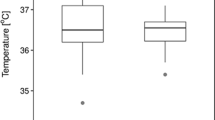Abstract
Given the available empirical evidence on the benefits and costs associated with immune defence, a role for the immune system in the trade-off between current and future reproduction has been predicted. This hypothesis was studied in a free-living population of great tits (Parus major) by examining the effects of male removal on the immunocompetence, body condition, and recapture probability in the widowed females and their nestlings. Furthermore, we investigated whether growth and its relation to immunocompetence were affected in the nestlings. For a short-lived species such as the great tit, one could predict that widowed females will compensate for the lack of any male assistance in feeding of their chicks and that they consequently might jeopardize their own health. However, we did not find any negative effects of male removal on body mass or condition, nor on humoral immunocompetence against sheep red blood cells in the widowed females by the end of the feeding period. In contrast, we observed significantly reduced body mass and size as well as a reduced T-lymphocyte cell-mediated immune response (expressed as the thickness of the swelling to a subcutaneous injection with phytohemagglutinin) in the experimental nestlings compared to the control nestlings. In addition, the experimental nestlings showed a tendency for a reduced chance to be found breeding the following year. Furthermore, our results showed that in the experimental nestlings, which suffered from unfavourable growth conditions, tarsus length was inversely related to cell-mediated immunocompetence, whereas in control nestlings this relationship was significantly positive. The relationship between cell-mediated immunity and body condition was found to be significantly positive in the experimental nestlings while in control nestlings there was no relationship between both variables. The latter finding suggests different priorities of investment in body condition between different growth conditions.



Similar content being viewed by others
References
Alonso-Alvarez C, Tella JL (2001) Effects of experimental food restriction and body mass changes on the avian T-cell-mediated immune response. Can J Zool 79:101–105
Ardia DR, Schat KA, Winkler DW (2003) Reproductive effort reduces long-term immune function in breeding tree swallows (Tachycineta bicolor). Proc R Soc Lond B Biol Sci 270:1679–1683
Birkhead TR, Fletcher F, Pellatt EJ (1999) Nestling diet, secondary sexual traits and fitness in the zebra finch. Proc R Soc Lond B Biol Sci 266:385–390
Björklund M, Westman B (1986) Adaptive advantages of monogamy in the great tit (Parus major): an experimental test of the polygyny threshold model. Anim Behav 34:1436–1440
Bjørnstad G, Lifjeld JT (1996) Male parental care promotes early fledging in an open-nester, the willow warbler Phylloscopus trochilus. Ibis 138:229–235
Brinkhof MWG, Heeb P, Kölliker M, Richner H (1999) Immunocompetence of nestling great tits in relation to rearing environment and parentage. Proc R Soc Lond B Biol Sci 266:2315–2322
Brommer JE (2004) Immunocompetence and its costs during development: an experimental study in blue tit nestlings. Proc R Soc Lond B Biol Sci (Suppl) 271:S110–S113
Christe P, Møller AP, de Lope F (1998) Immunocompetence and nestling survival in the house martin: the tasty chick hypothesis. Oikos 83:175–179
Cichoń M, Dubiec A, Chadzińska M (2001) The effect of elevated reproductive effort on humoral immune function in collared flycatcher females. Acta Oecologia 22:71–76
Clutton-Brock TH (ed) (1988) Reproductive success. University of Chicago Press, Chicago
Cramp S, Perrins CM (eds) (1993) Parus major Great tit. In: Handbook of the birds of Europe, the Middle East and North Africa: the birds of the Western Paleartic, vol VII. Oxford University Press, Oxford, pp 255–281
Deerenberg C, Apanius V, Daan S, Bos N (1997) Reproductive effort decreases antibody responsiveness. Proc R Soc Lond B Biol Sci 264:1021–1029
Faivre B, Préault M, Salvadori F, Théry M, Gaillard M, Cézilly F (2003) Bill colour and immunocompetence in the European blackbird. Anim Behav 65:1125–1131
Gustafsson L, Sutherland WJ (1988) The cost of reproduction in the collared flycatcher. Nature 335:813–817
Hõrak P (2003) When to pay the cost of reproduction? A brood size manipulation experiment in great tits (Parus major). Behav Ecol Sociobiol 54:105–112
Hõrak P, Tegelmann L, Ots I, Møller AP (1999) Immune function and survival of great tit nestlings in relation to growth conditions. Oecologia 121:316–322
Hamilton WD, Zuk M (1982) Heritable true fitness and bright birds: a role for parasites? Science 218:384–386
Hasselquist D, Wasson MF, Winkler DW (2001) Humoral immunocompetence correlates with date of egg-laying and reflects work load in female tree swallows. Behav Ecol 12:93–97
Hudson L, Hay FC (1989) Practical immunology. Blackwell, Oxford
Ilmonen P, Taarna T, Hasselquist D (2000) Experimentally activated immune defence in female pied flycatchers results in reduced breeding success. Proc R Soc Lond B Biol Sci 267:665–670
Ims RA, Hjermann DØ (2001) Condition-dependent dispersal. In: Clobert J, Danchin E, Dhondt AA, Nichols JD (ed) Dispersal. Clarendon, Oxford, pp 203–216
Klasing KC (1998) Nutritional modulation of resistance to infectious diseases. Poult Sci 77:1119–1125
Lessells CM, Boag PT (1987) Unrepeatable repeatabilities: a common mistake. Auk 104:116–121
Lindén M, Møller AP (1989) Clutch size, cost of reproduction, and covariation of life history traits in birds. Trends Ecol Evol 4:367–371
Lochmiller RL, Deerenberg C (2000) Trade-offs in evolutionary immunology: just what is the cost of immunology? Oikos 88:87–98
Lochmiller R, Vestey MR, Boren JC (1993) Relationship between protein nutritional status and immunocompetence in northern bobwhite chicks. Auk 110:503–510
Lyon BE, Montgomerie RD, Hamilton LD (1987) Male parental care and monogamy in snow buntings. Behav Ecol Sociobiol 20:377–382
McCleery RH, Perrins CM (1988) Lifetime reproductive success of the great tit, Parus major. In: Clutton-Brock TH (ed) Reproductive success. University of Chicago, Chicago, pp 136–153
Møller AP, Saino N (2004) Immune response and survival. Oikos 104:299–304
Moreno J (1993) Physiological mechanisms underlying reproductive trade-offs. Etología 3:41–56
Moreno J, Sanz JJ, Arriero E (1999) Reproductive effort and T-lymphocyte cell-mediated immunocompetence in female pied flycatchers Ficedula hypoleuca. Proc R Soc Lond B Biol Sci 266:1105–1109
van Noordwijk AJ, de Jong G (1986) Acquisition and allocation of resources: their influence on variation in life history tactics. Am Nat 128:137–142
Nordling D, Andersson MS, Zohari S, Gustafsson L (1998) Reproductive effort reduces specific immune response and parasite resistance. Proc R Soc Lond B Biol Sci 265:1291–1298
Norris K, Evans MR (2000) Ecological immunology: life history trade-offs and immune defense in birds. Behav Ecol 11:19–26
Ots I, Hõrak P (1996) Great tits Parus major trade health for reproduction. Proc R Soc Lond B Biol Sci 263:1443–1447
Perrins CM (1965) Population fluctuations and clutch size in the great tit, Parus major. J Anim Ecol 34:601–647
Råberg L, Nilsson J-Å, Ilmonen P, Stjernman M, Hasselquist D (2000) The cost of an immune response: vaccination reduces parental effort. Ecol Lett 3:382–386
Reid WV (1987) The cost of reproduction in the glaucous-winged gull. Oecologia 74:458–467
Rice WR (1989) Analyzing tables of statistical tests. Evolution 43:223–225
Roff DA (1992) The evolution of life histories. Chapman and Hall, New York
Saino N, Bolzern AM, Møller AP (1997a) Immunocompetence, ornamentation and viability of male barn swallows (Hirundo rustica). Proc Natl Acad Sci USA 94:549–552
Saino N, Calza S, Møller AP (1997b) Immunocompetence of nestling barn swallows in relation to brood size and parental effort. J Anim Ecol 66:827–836
Saino N, Calza S, Møller AP (1998) Effects of a dipteran ectoparasite on immune response and growth trade-offs in barn swallows, Hirundo rustica, nestlings. Oikos 81:217–228
SAS for Windows (1999–2000) SAS/STAT User’s guide release 8.1 edition. SAS Institute, Cary
Sasvári L (1986) Reproductive effort of widowed birds. J Anim Ecol 55:553–564
Smits JE, Bortolotti GR, Tella JL (1999) Simplifying the phytohaemagglutinin skin-testing technique in studies of avian immunocompetence. Funct Ecol 13:567–572
Snoeijs T (2004) Avian immunocompetence in relation to sexual selection, life history decisions, and environmental pollution. PhD Thesis, University of Antwerp
Snoeijs T, Van de Casteele T, Adriaensen F, Matthysen E, Eens M (2004) A strong association between immune responsiveness and natal dispersal in a songbird. Proc R Soc Lond B Biol Sci (Suppl) 271:S199–S201
Soler JJ, Møller AP, Soler M, Martinez JG (1999) Interactions between a brood parasite and its host in relation to parasitism and immune defence. Evol Ecol Res 1:189–210
Soler JJ, de Neve L, Pérez-Contreras T, Soler M, Sorci G (2003) Trade-off between immunocompetence and growth in magpies: an experimental study. Proc R Soc Lond B Biol Sci 270:241–248
Szép T, Møller AP (1999) Cost of parasitism and host immune defence in the sand martin Riparia riparia: a role for parent–offspring conflict? Oecologia 119:9–15
Tinbergen JM, Boerlijst MC (1990) Nestling weight and survival in individual great tits Parus major. J Anim Ecol 59:1113–1128
Tinbergen JM, Verhulst S (2000) A fixed energetic ceiling to parental effort in the great tit? J Anim Ecol 69:323–334
Tremblay I, Thomas DW, Lambrechts MM, Blondel J, Perret P (2003) Variation in Blue Tit breeding performance across gradients in habitat richness. Ecology 84:3033–3043
Trivers RL (1974) Parent–offspring conflict. Am Zool 14:249–264
Van Duyse E, Pinxten R, Eens M (2000) Does testosterone affect the trade-off between investment in sexual/territorial behaviour and parental care in male great tits? Behaviour 137:1503–1515
Van Duyse E, Pinxten R, Eens M (2002) Effects of testosterone on song, aggression, and nestling feeding behavior in male great tits, Parus major. Horm Behav 41:178–186
Verhulst S (1995) Reproductive decisions in great tits, an optimality approach. PhD Thesis, University of Groningen
Verhulst S, Dieleman SJ, Parmentier HK (1999) A trade-off between immunocompetence and sexual ornamentation in domestic fowl. Proc Natl Acad Sci USA 96:4478–4481
Whillans KV, Falls JB (1990) Effects of male removal on parental care of female white-throated sparrows, Zonotrichia albicollis. Anim Behav 39:869–878
Willis GM, Baker DH (1981) Interaction between dietary protein/amino acid level and parasitic infection: morbidity in amino acid deficient or adequate chicks inoculated with Emeria acervulina. J Nutr 111:1157–1163
Zuk M, Stoehr AM (2002) Immune defense and host life history. Am Nat 160:S9–S22
Acknowledgements
We would like to thank Peter Scheys for his field assistance, and László Garamszegi and three anonymous referees for their valuable comments on earlier drafts. T. Snoeijs is a Research Assistant of the Fund for Scientific Research—F.W.O.-Flanders (Belgium). This research was supported by Research Projects (G.0075.98 and G.0420.02) of the F.W.O.-Flanders (Belgium).
Author information
Authors and Affiliations
Corresponding author
Additional information
Communicated by Roland Brandl
An erratum to this article is available at http://dx.doi.org/10.1007/s00442-005-0190-5.
Rights and permissions
About this article
Cite this article
Tinne, S., Rianne, P. & Marcel, E. Experimental removal of the male parent negatively affects growth and immunocompetence in nestling great tits. Oecologia 145, 165–173 (2005). https://doi.org/10.1007/s00442-005-0088-2
Received:
Accepted:
Published:
Issue Date:
DOI: https://doi.org/10.1007/s00442-005-0088-2




